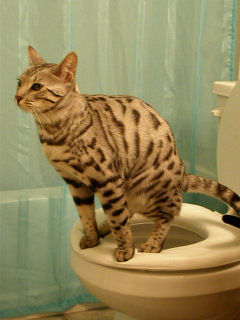Discovering the Dangers of Flushing Animal Waste Down the Toilet
Discovering the Dangers of Flushing Animal Waste Down the Toilet
Blog Article
Almost everyone has their personal thoughts in relation to Don't Flush Your Pets Poo Down The Loo, Vet Warns.

When it comes to getting rid of waste, particularly animal waste, many people typically turn to the convenient choice of flushing it down the commode. However, this apparently easy service can have severe effects for the atmosphere and public health. In this post, we'll explore why flushing animal waste down the toilet is a bad concept and supply alternate approaches for correct disposal.
Introduction
Proper waste disposal is vital for keeping environmental sustainability and public health. While it may seem harmless to purge animal waste down the bathroom, it can lead to different problems, both for the atmosphere and human wellness.
Dangers of flushing animal waste
Ecological effect
Purging pet waste presents damaging bacteria and pathogens right into rivers, which can negatively impact marine ecological communities. These microorganisms can pollute water resources and injury marine life, interrupting delicate ecological communities.
Public health problems
Pet waste has harmful microorganisms such as E. coli and Salmonella, which can position major health dangers to humans. Flushing pet waste down the bathroom can infect water products, bring about the spread of illness and infections.
Alternatives to flushing
As opposed to flushing pet waste down the toilet, there are a number of alternate disposal methods that are much more environmentally friendly and sanitary.
Composting
Composting pet waste is an eco-friendly way to throw away it. By composting, organic matter is broken down right into nutrient-rich soil, which can be utilized to fertilize yards and plants.
Landfill disposal
Taking care of pet waste in a landfill is one more alternative. While not as environmentally friendly as composting, it is a much safer option to flushing, as it avoids the contamination of water sources.
Pet dog waste disposal systems
There are specific family pet waste disposal systems available that securely and hygienically get rid of pet waste. These systems usually make use of enzymes to break down waste and get rid of smells.
Actions to proper pet waste disposal
To make certain appropriate disposal of pet waste, follow these actions:
Scooping and getting waste
Consistently scoop and bag pet waste making use of naturally degradable bags. This protects against waste from infecting the atmosphere.
Utilizing assigned waste containers
Dispose of bagged animal waste in assigned waste containers, such as compost bins or garbage dump containers. Avoid flushing it down the commode in all prices.
Cleansing can and family pet locations consistently
Frequently clean litter boxes and pet dog areas to stop the build-up of waste and germs. Use pet-safe cleansing products to preserve health.
Advantages of appropriate disposal techniques
Taking on proper disposal techniques for animal waste supplies a number of benefits:
Lowered environmental pollution
Appropriate disposal approaches minimize the threat of environmental pollution, protecting waterways and communities from contamination
Lessened danger of water contamination.
By avoiding flushing pet more info waste down the toilet, the risk of water contamination is dramatically reduced, securing public health.
Boosted hygiene and health
Proper disposal methods promote better hygiene and health, developing a safer environment for both people and pets.
Final thought
To conclude, flushing animal waste down the toilet is damaging to the atmosphere and public health. By embracing alternate disposal methods and following correct waste monitoring practices, we can decrease the adverse impact of animal waste and add to a cleaner, healthier world.
What To Do With Dog Poo – The Do's And Don'ts Of Disposing Of Faeces
Dog poo bins
Some councils provide dedicated dog waste bins in popular dog-walking areas that can take dog poo that has been bagged but you can legally dispose of dog waste in any public litter bin, as long as it is securely bagged. This also applies to your wheelie bin at home.
Do not flush
Water companies do not recommend flushing dog faeces down the toilet because certain parasites can survive the water processing treatment and are potentially harmful to humans. You should also never consider flushing dog poo that has been bagged down the toilet as the bags will not break down and instead create severe blockages in the sewage system.
In the woods
The Forestry Commission promotes a ‘stick and flick’ method for dealing with waste in the woods. This means finding a stick and using it to flick any poo from off the path so that it is out of the way of other walkers. You could also bury it as long as it is not in an area where there might be livestock.
Livestock
Parasites found in dog poo can be transmitted to livestock if they inadvertently eat infected faeces that has been left on grazing land. This could result in the death of sheep or abortion in cattle so you should always make sure you pick up your dog’s waste in fields where livestock could be present.

Frequently clean litter boxes and pet dog areas to stop the build-up of waste and germs. Use pet-safe cleansing products to preserve health.
Advantages of appropriate disposal techniques
Taking on proper disposal techniques for animal waste supplies a number of benefits:
Lowered environmental pollution
Appropriate disposal approaches minimize the threat of environmental pollution, protecting waterways and communities from contamination
Lessened danger of water contamination.
By avoiding flushing pet more info waste down the toilet, the risk of water contamination is dramatically reduced, securing public health.
Boosted hygiene and health
Proper disposal methods promote better hygiene and health, developing a safer environment for both people and pets.
Final thought
To conclude, flushing animal waste down the toilet is damaging to the atmosphere and public health. By embracing alternate disposal methods and following correct waste monitoring practices, we can decrease the adverse impact of animal waste and add to a cleaner, healthier world.
What To Do With Dog Poo – The Do's And Don'ts Of Disposing Of Faeces
Dog poo bins
Some councils provide dedicated dog waste bins in popular dog-walking areas that can take dog poo that has been bagged but you can legally dispose of dog waste in any public litter bin, as long as it is securely bagged. This also applies to your wheelie bin at home.
Do not flush
Water companies do not recommend flushing dog faeces down the toilet because certain parasites can survive the water processing treatment and are potentially harmful to humans. You should also never consider flushing dog poo that has been bagged down the toilet as the bags will not break down and instead create severe blockages in the sewage system.
In the woods
The Forestry Commission promotes a ‘stick and flick’ method for dealing with waste in the woods. This means finding a stick and using it to flick any poo from off the path so that it is out of the way of other walkers. You could also bury it as long as it is not in an area where there might be livestock.
Livestock
Parasites found in dog poo can be transmitted to livestock if they inadvertently eat infected faeces that has been left on grazing land. This could result in the death of sheep or abortion in cattle so you should always make sure you pick up your dog’s waste in fields where livestock could be present.

Do you like reading up on ? Post a remark further down. We'd be glad to hear your thoughts about this article. We are looking forward that you come back again later on. Sharing is caring. Helping others is fun. I praise you for your time. Revisit us soon.
Go Deal Now Report this page